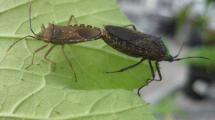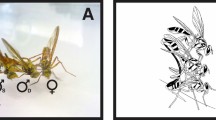Summary
Adult female whitespotted sawyers Monochamus scutellatus (Coleoptera: Cerambycidae) were placed on succeeding days with two males differing visibly in size. Females showed a significant preference for the larger of two males. The rate of oviposition was significantly higher when the female was paired with the larger male. Both the rate of movement by the paired female and her rate of indicating non-receptivity were significantly lower when the female was paired with the larger male. This species exhibits resource defense polygyny, and females appear to choose mates mainly on the basis of the quality of resources defended. This study suggests, however, that when resource quality is constant, females choose mates on the basis of their size.
Similar content being viewed by others
References
Borgia G (1979) Sexual selection and the evolution of mating systems. In: Blum MS, Blum NA (eds) Sexual selection and reproductive competition in insects. Academic Press, New York, pp 19–80
Chapman RF (1971) The insects: structure and function. Elsevier, New York
Dominey WJ (1983) Sexual selection, additive genetic variance and the “phenotypic handicap”. J Theor Biol 101:495–502
Emlen ST, Oring LW (1977) Ecology, sexual selection, and the evolution of mating systems. Science 197:215–223
Hughes AL (1979) Reproductive behavior and sexual dimorphism in the whitespotted sawyer, Monochamus scutellatus (Say). Coleopt Bull 33:45–47
Hughes AL (1981) Differential male mating success in the whitespotted sawyer, Monochamus scutellatus (Coleoptera: Cerambycidae). Ann Entomol Soc Am 74:180–184
Hughes AL, Hughes MK (1982) Male size, mating success, and breeding habitat partitioning in the whitespotted sawyer, Monochamus scutellatus (Say) (Coleoptera: Cerambycidae). Oecologia 55:258–263
Johnson LK (1982) Soxual selection in a tropical brentid weevil. Evolution 36:251–262
Rose AH (1957) Some notes on the biology of Monochamus scutellatus (Say) (Coleoptera: Cerambycidae). Can Entomol 89:547–553
Schlager G (1960) Sperm precedence in the fertilization of eggs in Tribolium castaneum. Ann Entomol Soc Am 53:557–560
Smith RL (1979) Repeated copulation and sperm precedence: paternity assurance for a male brooding water bug. Science 205:1029–1031
Thornhill R (1983) Cryptic female choice and its implications in the scorpionfly, Harpobittacus nigriceps. Am Nat 122:265–288
Thornhill R, Alcock J (1983) The evolution of insect mating systems. Harvard University Press, Cambridge, MA
Author information
Authors and Affiliations
Rights and permissions
About this article
Cite this article
Hughes, A.L., Hughes, M.K. Female choice of mates in a polygynous insect, the whitespotted sawyer Monochamus scutellatus . Behav Ecol Sociobiol 17, 385–387 (1985). https://doi.org/10.1007/BF00293217
Received:
Accepted:
Issue Date:
DOI: https://doi.org/10.1007/BF00293217




